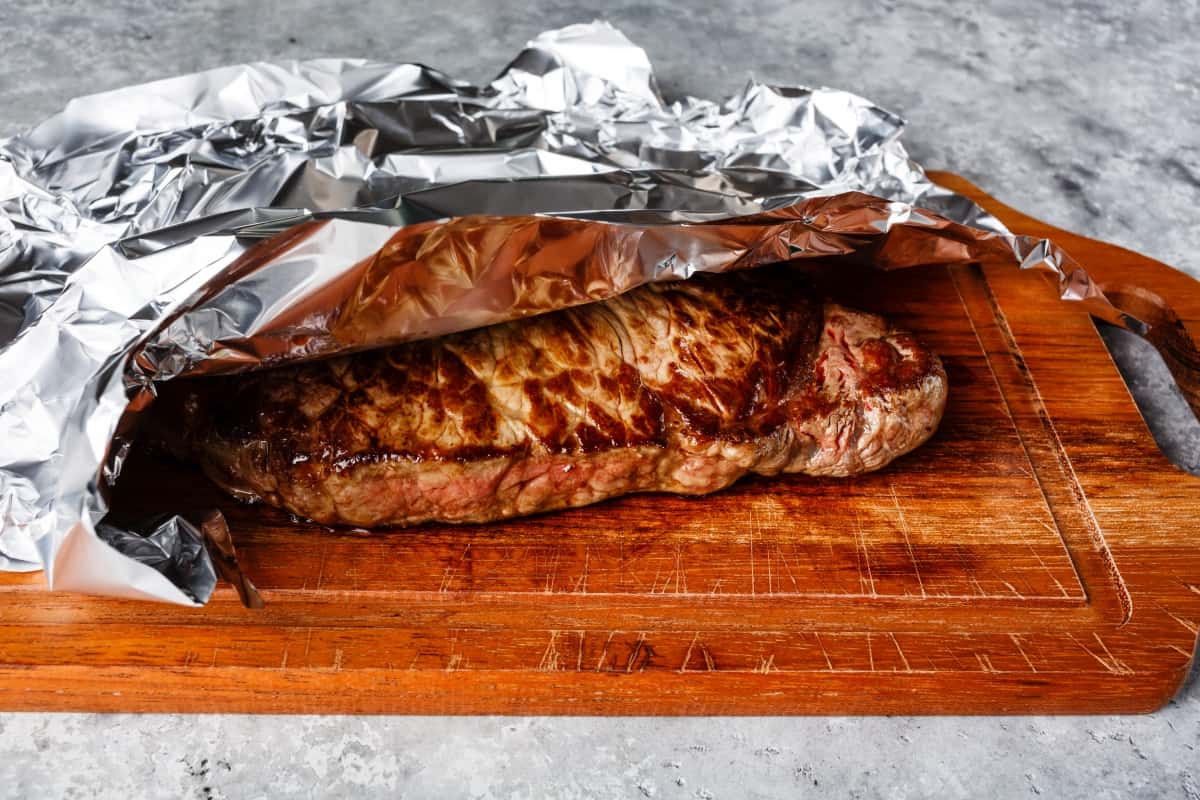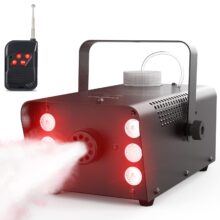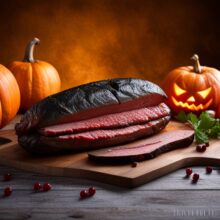How Long to Rest Steak

When you cook steaks, you’ll want to let them rest afterward. This will help the meat retain moisture. In addition, it will allow it to cool down. A probe thermometer is an excellent way to monitor the temperature of the meat during the resting process. But, it’s important to keep two things in mind: Do not puncture the meat while it is resting.
Resting meat after cooking helps retain moisture
Resting meat after cooking helps to retain moisture and flavor. The process involves holding the meat at a low temperature to redistribute the juices. The process can take a long time. But, the results are worth it. In fact, it increases the juiciness of the final product.
The main reason why resting meat after cooking helps to retain moisture is that the fibers in the meat push the juices to the center of the cut. Slicing the meat right after cooking will reduce this redistribution, resulting in tough, dry meat. Resting the meat before carving it allows the fibers to relax, allowing the juices to redistribute and re-absorb into the meat.
Depending on the cut of meat, the internal temperature of the meat may rise by several degrees even after resting. This is called “carryover cooking” and affects meat with a larger and thicker cut. To avoid this, it’s best to remove the meat from the heat source at a slightly lower temperature than the final desired internal temperature.
Besides being essential for flavor and texture, the resting process helps retain moisture after cooking. It also prevents loss of flavorful juices when cutting the meat. During the cooking process, the proteins in the meat undergo a chemical reaction that reabsorbs moisture from their cells. This is what makes meat juicy and tender.
The process of resting meat after cooking is beneficial for all cuts of meat. The amount of time the meat needs to rest varies, but it is important to remember that larger cuts of meat require longer resting. A general rule is to allow meat to sit for one minute per 100 grams of meat.
While the process of resting may sound tedious and unnecessary, it is beneficial for the taste of the meat. The meat tends to lose moisture when left at room temperature for a long time. Furthermore, the fat on the meat is soft when hot, contributing to the juiciness of the meat. As a result, it can become waxy and rubbery when left to cool.
After cooking meat, it is important to let it rest for at least 10 minutes. This is not only good for the taste and health but also helps to retain the moisture. The resting period varies with the size of the meat and the temperature at which it reached during the cooking process. Thinner cuts of meat, such as loins and ribs, need only a few minutes to rest before being served, while thicker cuts should be allowed to rest for between ten to twenty minutes.
Allowing it to cool down helps it cool down
Allowing steak to cool down is a critical part of the cooking process. Allowing the meat to cool down properly will help it remain moist and tender. It is especially important to allow it to rest for a few minutes after cooking. Resting the meat will allow the juices to migrate back to the center and redistribute throughout the meat. If the meat is overcooked, the cells will not bounce back like this and the juices will evaporate from the meat.
Another reason to rest a steak is that it will let the residual heat of the cooking process continue to cook the meat. Ideally, the steak will have only a few threads of fat that have set and the juices to pool. When this happens, the steak is done and ready to be cut into.
Monitoring the temperature of the meat with a probe thermometer
If you’re worried about overcooking your steak, try monitoring the temperature with a probe thermometer. These devices use an electronic sensor that sits inside the probe and is connected to a display. Many models have an alarm that sounds when the temperature reaches a specific point. You can also get wireless meat thermometers that don’t need to be near the meat.
Most meat thermometers are inaccurate, so make sure to calibrate your thermometer regularly. You can do this by inserting the probe at a depth of two inches into the meat and ensuring that the probe is inserted at the right angle. In addition, it’s best to use a thermometer that is oven-safe, especially if you’re using it to monitor the temperature of a steak.
The meat thermometer is most useful when cooking a large piece of meat, such as a large roast or whole turkey. Using a meat thermometer is an easy way to cook a large piece of meat without risking the safety of your food. A meat thermometer can also help with grilling steaks or roasts.
Digital instant-read meat thermometers are another convenient option. They measure internal temperatures of meat and display the results on the display. Instant meat thermometers from ThermoPro are easy to use and come with a backlit display and a screwdriver for replacing the batteries. These thermometers can reach the thickest part of the steak. This way, you can accurately measure the temperature of the core.
Probe thermometers are available with a single probe or multiple probes. Single probe models are usually the most affordable option. Single probe thermometers allow you to monitor one area of the meat, but you can use multiple probes if you need to monitor a larger portion of the meat. The more probes a thermometer has, the more accurate it will be.
When shopping for a meat thermometer, make sure that the unit covers the full temperature range. This will make your life easier while grilling. Buying a meat thermometer will also help you save money and avoid risking undercooked meat.
Avoiding puncturing the meat after it has rested
When cooking steak, it is best to avoid puncturing it after it has rested. This can result in a flood of juices. It is best to use a meat thermometer to ensure a safe internal temperature. Poking the steak with a fork won’t give you accurate results, and it will also release juices and lose its moisture content.
Another common mistake is piercing the steak. This technique allows the juices to escape, which helps the steak cook evenly. It also prevents the steak from becoming dry when cooked. Moreover, it will make the steak tender. To avoid this mistake, make sure that you pierce the steak with a fork or a knife. Turning and flipping the meat often is also recommended.
If you are unable to rest the steak, you will end up overcooking it. This will cause it to lose its juicy juices. It will also be cold to eat. In addition, overresting the meat can lead to bacterial growth. This could lead to food poisoning. Using an internal meat thermometer is not recommended because it can lead to juice leakage. Therefore, it is recommended that you use a thermometer that is not inaccurate. This way, you’ll ensure that the meat is cooked at the right temperature.
Although puncturing the steak before cooking increases its tenderness, it also decreases the flavor. This is because the steak is soaked in marinade and has a tendency to lose its shape. Besides, it can also cause the steak to toughen. As a result, it’s best to avoid puncturing the steak after it has rested.
Read more great BBQ articles at Bob's BBQ Tips
Did you miss our previous article…
https://notoriousbob.net/?p=2304



